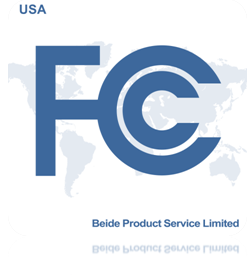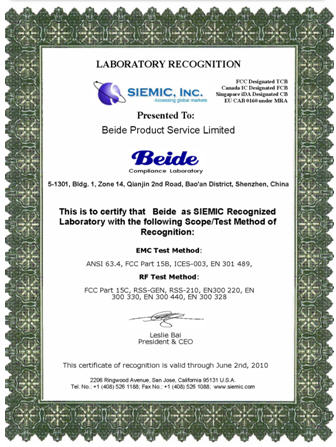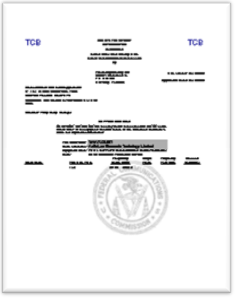Summary of Certification Content

FCC stands for Federal Communications Commission (FCC). FCC certification is a testing certification related to electromagnetic compatibility. The FCC in the United States regulates the electromagnetic interference generated by electronic products with operating frequencies above 9KHZ. Electronic and electrical products sold to the United States require application for FCC certification and labeling with FCC markings.
The Federal Communications Commission (FCC) in the United States used to use different certification methods for electronic products based on product types. There were three types of certification methods: Verification, DoC (Declaration of Conformity), and Certification. However, starting from November 2, 2017, the FCC merged DoC and Verification into SDoC (Supplier's Declaration of Conformity) and revised the relevant FCC provisions, with a transition period of one year.
Regarding the transitional period, from November 2, 2017 to November 2, 2018 is the transitional operation period. During this transitional period, the FCC VOC and DoC certification programs can continue to be used, or the new FCC SDoC certification program can be used. After a one-year transition period, the FCC SDoC certification program will officially replace the original FCC VOC and DoC certification methods. Overall, the FCC SDoC certification program is more simplified and clear than the original program, allowing for the use of electronic labels while reducing cumbersome import declaration requirements. The purpose is to simplify the current cumbersome and complex FCC certification requirements and further reduce the burden on enterprises.
The SDoC certification program requires a test report to be issued. In order to make the report more authoritative, it is recommended to test in the FCC Recognized Certified laboratory as much as possible. Strictly following the requirements of the ISO 17025 system, SDOC's testing still follows the previous testing standards, and the key modifications are as follows:
·Part 15: Unintentional Radiation Products
1. For FCC Part 15 products, if the stand alone cable input selector switch is used, the following text content needs to be prominently placed in the product:
This device complies with Part 15 of the FCC Rules for use with cable television service
2. For products applicable to FCC Part 15, if the product is too small to include FCC 15.19 Statement and there is no built-in screen to display FCC 15.19 Statement, the statement content required by FCC 15.19 must be included in the user manual, and must be placed on the product packaging or attached to the product with a removable label.
3. For unintended radiation products applicable to FCC Part 15, the certification method is modified as follows:
Type of device | Equipment authorization
required |
TV Broadcast Receiver | SDoC or Certification. |
FM Broadcast Receiver | SDoC or Certification. |
CB Receiver | SDoC or Certification. |
Superregenerative Receiver | SDoC or Certification. |
Scanning Receiver | Certification. |
Radar Detector | Certification. |
All other receivers subject to Part 15 | SDoC or Certification. |
TV Interface Device | SDoC or Certification. |
Cable System Terminal Device | SDoC or Certification. |
Stand-alone Cable input selector switch | SDoC or Certification. |
Class B personal computers and peripherals | SDoC or Certification. |
CPU boards and internal power supplies used with Class B personal computers | SDoC or Certification. |
Class B personal computers assembled using authorized CPU boards or power supplies | SDoC or Certification. |
Class B external switching power supplies | SDoC or Certification. |
Other Class B digital devices & peripherals | SDoC or Certification. |
Class A digital devices, peripherals & external switching power supplies | SDoC or Certification. |
Access Broadband over Power Line (Access BPL) | Certification. |
All other devices | SDoC or Certification. |
·Part 18: Intended Radiation Products
1. For products applicable to FCC Part 18, commercial industrial, scientific, and medical products must be certified through SDoC or Citizenship, while commercial ultrasound products (less than 500 watts and operating frequency less than 90 kHz) and non commercial industrial, scientific, and medical products must be certified through SDoC.
2. For intended radiation products that comply with FCC Part 18, electronic screens are allowed to present compliant statements.
3. For the SDoC of products, there needs to be a local responsible agency in the United States to ensure that the products comply with relevant regulations, which can be a manufacturer or importer.
·Certification:
1. For certification products, electronic screens will be allowed to present FCC IDs; If the FCC ID cannot be labeled on the product due to its small size and there is no electronic screen to display the FCC ID, the FCC ID must be included in the user manual and placed on the product packaging or attached to the product with a removable label.
2. The testing and certification of Certificate is mandatory to be carried out in the laboratory of FCC Certified.
·For SDoC products, customers can voluntarily place the FCC logo prominently on the product's appearance.
·If the product needs to be tested and certified through SDoC, the following information needs to be provided when the product is launched or imported. This information can be included in the user manual or presented in another document:
1. The name and model of the product,
2. The statement declaring the product to comply with FCC regulations,
3. Information about the local responsible agency in the United States, including name, address, phone number, or internet contact information.
·If the user manual is not provided in paper form and may be used on a hard drive or through the Internet, the above information must be included in the user manual for provision to the user; In addition, information can also be presented through electronic screens.
·During the transition period:
1. Products that have passed the FCC SDoC certification program will have the freedom to choose whether to mark or not to mark the FCC logo;
2. SDoC requires the addition of a compliance declaration file to the equipment accompanying file, which must include necessary information such as the name, address, or contact website of the local supplier in the United States;
3. During the transition period, you can choose to continue using FCC VOC and DoC certification programs;
4. The FCC VOC and DoC certification procedures conducted before the transition period are always valid. If the product is modified, it needs to be re certified.

FCC Authorization Letter (NB2200)
Note: If a certain device is suitable for two or three recognized types, it is up to the responsible party to choose.
The responsible party shall make the following markings on the equipment applicable to the declaration of conformity:



For equipment applicable to certification certificates (usually manufacturers or importers), the responsible party should make the equipment labeled with FCCID.